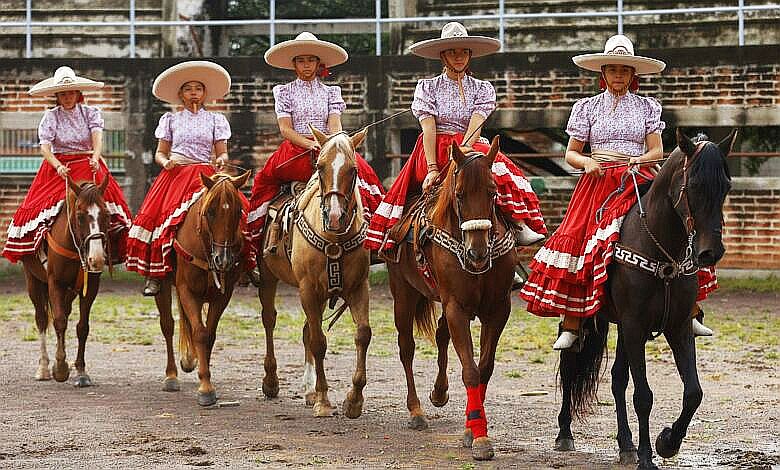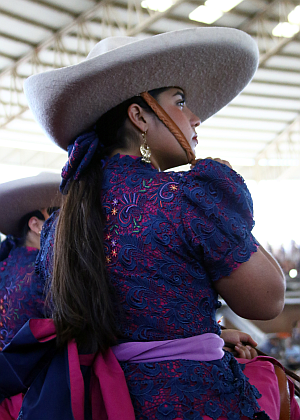
Guadalajara, Mexico – With their elegance and courage, the “escaramuzas” – or charro women from Jalisco – are forging boldly ahead by founding a school to train young and teenage girls in horsemanship and “charreria,” Mexico’s national sport that is usually dominated by men.
The centuries-old tradition of Charrería brings together working skills, training and discipline, horsemanship, music and dance, and symbolic reenactment of Mexican values and customs. Like its rodeo cousin in the U.S., Charrería turns cattle farming skills into competitive stunts. Contending teams show off techniques of jumping through the air onto wild mares, riding bucking broncos and bringing down rampaging bulls with lassos.
The school for girls officially opened its doors in San Martin de Hidalgo, Jalisco, in September, the month when Mexico celebrates its independence, and it is the first one endorsed by the state government in an effort to instill in young women a love of “escaramuza charreria,” a stylized, artistic form of rodeo-oriented horseback riding practiced exclusively by the escaramuzas.
Esther Venegas Rodriguez, born in San Martin de Hidalgo, a community in the Jalisco valley region, told EFE on Wednesday that she’s been riding horses since she was quite young and four years ago she decided to become an escaramuza.
Her love for this aspect of horseback riding led her to push forward with creating the rodeo school in her town and she quickly got a response, not only from girls who already knew about the sport but also from others who were approaching it for the first time.
Although it’s a variant of regular competitive horseback riding, the escaramuzas have their own identity and their own types of rodeo riding exercises that require courage, broad knowledge of horses, the ability to control them and a great deal of coordination, she said.
“All the exercises create a routine whereby we earn points in competitions, but the most important thing is to have the courage to get up on a horse. Girls already have that love for horses, so it’s only necessary to train them in coordination and being alert,” she said.
Venegas Rodriguez has the sincere smile of women of Mexico’s villages, where competitive rodeo-style horseback riding is a natural part of daily life, and practiced on ranches and farms in Jalisco as a form of entertainment among the landowners and their hired hands.
The practice spread to other parts of the country and, over time, it also reached the cities.
In recent years, Mexico’s rodeo riders have created organizations for the sports’ professionals, with “charreria” being declared by Unesco to be part of the intangible cultural heritage of humanity in 2018.

Two or three times a week, about a dozen girls between 10 and 15 years of age get ready to go to the “lienzo charro” in San Martin de Hidalgo to hone their rodeo skills.
There, the girls compete in various riding events, but the “lienzo charro” also functions as a school to teach them new skills.
Instead of bringing a satchel containing her riding accoutrements, each girl arrives at the school in a pickup truck with a trailer. Inside the trailer is her horse, to whom she generally owes a good portion of her success on the riding team.
The students don their training clothing, spurs, boots and put up their long hair, while their parents put protective coverings on the horses’ hooves and the special escaramuza saddles on their backs whereby the riders can sit sideways and perform their various riding exercises without falling off.
During the training sessions, they practice various techniques for controlling their mounts. The rodeo is divided into four quarters and the riders come and go from the sidelines to the center and perform their flourishes, circles and other motions, including the so-called “coladeras,” where four riders gallop past one another at full speed.
“The more dangerous an exercise is, the more you must concentrate to avoid a fall or a collision between the animals. Coordination is the most important thing to be able to control the horses,” Stefany Celina Lopez, an escaramuza and the mother of one of the girls on the team, told EFE.
She added that knowing your horse is fundamental in being an escaramuza, because if horse and rider have no “chemistry” or “connection,” they won’t be able to engage in worthwhile training together. Like riding bicycles together, the girls direct their horses while they chat and laugh.
At age 13, Veronica Alvarez has been training with her horse since she was 3. She began coming to Guadalajara to attend a riding association but when she learned about the rodeo school she decided to sign up to compete.
“You form a second family with the members of the escaramuza (team). Some exercises scare you but part of it is feeling the adrenaline. The hardest part is controlling your fear, everything else just flows. I get on my horse and I forget about everything,” she told EFE.
EFE article translated and edited by Mariana Gonzalez-Marquez for La Prensa Latina





